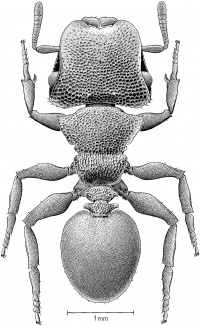Cephalotes obscurus
| †Cephalotes obscurus Temporal range: Burdigalian, Early Miocene Dominican amber, Dominican Republic | |
|---|---|

| |
| Scientific classification | |
| Kingdom: | Animalia |
| Phylum: | Arthropoda |
| Class: | Insecta |
| Order: | Hymenoptera |
| Family: | Formicidae |
| Subfamily: | Myrmicinae |
| Tribe: | Attini |
| Genus: | Cephalotes |
| Species: | †C. obscurus |
| Binomial name | |
| †Cephalotes obscurus (Vierbergen & Scheven, 1995) | |
One of a number of Cephalotes fossil species that are known from Dominican Amber.
Identification
A member of the coffeae clade differing from its sister species, Cephalotes sucinus, by the denser body foveae. C. obscurus shares with some of its most closely related species, like Cephalotes dieteri, Cephalotes integerrimus and Cephalotes bloosi the propodeum unarmed (the specimens Do-5487 and PE 111) or with three small lateral denticles (the holotype) and the pronotal lamellae long and continuous. It can be distinguished from the other three fossil species by the presence of a pair of denticles on the vertex. (de Andrade and Baroni Urbani 1999)
Keys including this Species
Distribution
This taxon was described from Dominican amber, Dominican Republic (Burdigalian, Early Miocene).
Castes
Nomenclature
The following information is derived from Barry Bolton's Online Catalogue of the Ants of the World.
- †obscurus. †Zacryptocerus obscurus Vierbergen & Scheven, 1995: 164, fig. 8 (w.) DOMINICAN AMBER (Dominican Republic, Miocene).
- Combination in Cephalotes: De Andrade & Baroni Urbani, 1999: 542.
- Status as species: De Andrade & Baroni Urbani, 1999: 542 (redescription).
Type Material
Holotype: Museum of Comparative Zoology, no. Museum of Comparative Zoology-9, examined by de Andrade and Baroni Urbani (1999).
Unless otherwise noted the text for the remainder of this section is reported from the publication that includes the original description.
Description
Worker
de Andrade and Baroni Urbani (1999) - Head subquadrate. Frontal carinae superficially crenulate and not upturned above the eyes. Vertexal angles broad, round to slightly truncate and with weakly crenulate margin. Vertexal margin gently concave medially. Vertex with a pair of denticles. Mandibles laterally angulate.
Mesosoma. Scapular angles absent or not visible in dorsal view. Anterior pronotal border straight, protruding anteriorly and passing into the sides with a long, weak concavity. Pronotal sides with a broad, long, continuous lamella with semitransparent border. Promesonotal suture superficially marked in the holotype only. Sides of the mesonotum armed with a pair of truncate or slightly round teeth. Propodeum with differentiate basal and declivous faces; sides of the basal face delimited anteriorly and posteriorly by an angle or by small, irregular denticles; declivous face of the propodeum converging posteriorly; an additional pair of small, irregular denticles on the middle of the declivous face of the propodeum visible in the holotype only.
Petiole. Anterior face truncate, posterior face superficially convex. Petiolar sides, medially, with a pair of small, obtuse or round teeth. Postpetiole convex in the middle; anterior half of the postpetiolar sides with a pair of broad, round teeth arising from the anterior border of the postpetiole and directed slightly forwards.
Gaster suboval, with a pair of anterolateral lamellae not surpassing the stigma posteriorly.
Fore coxae angulate. Mid and hind femora angulate. Mid and hind basitarsi flattened and broader at the base.
Sculpture. Head minutely reticulate-punctate and with dense foveae shallower, sparser and diminishing in size anteriorly. Ventral face of the head with the same type of sculpture as on the anterior part of the dorsum. Pronotum and mesonotum minutely reticulate-punctate and with foveae as on the posterior part of the head dorsum but with narrower interspaces. The reticulation becomes strongly longitudinally oriented on the propodeum. Pedicel with the same type of sculpture as the pronotum but with smaller foveae. Gastral tergites, sides of the first gastral sternite, remaining sternites and legs strongly reticulate. Center of the first gastral sternite shining.
Pilosity. Each fovea with an appressed, minutely clavate hair; similar hairs on the gastral tergites and on the legs Border of the vertexal angles, of the pronotum, of the peduncular projections, legs and border of the gastral tergites and sternites with similar but suberect, clubbed hairs. Border of the first and second gastral sternites with rare, thin, erect, pointed hairs.
Colour. Frontal carinae, vertexal angles, pronotal lamellae and gastral lamellae ferruginous and semitransparent.
Measurements (in mm) and indices: TL 4.02-4.88; HL 0.98-1.16; HW 1.28-1.44; EL 0.27-0.30; PW 1.14-1.36; PeW 0.50-0.52; PpW 0.51-0.56; HBaL 0.38-0.42; HBaW 0.14; CI 124.1-130.6; PI 105.9-112.3; PPeI 228.0-261.5; PPpI 223.5-242.8; HBaI 33.3-36.8.
References
- de Andrade, M. L.; Baroni Urbani, C. 1999. Diversity and adaptation in the ant genus Cephalotes, past and present. Stuttgarter Beitrage zur Naturkunde Series B (Geolgie and Palaontologie). 271:1-889. (page 542, Combination in Cephalotes)
- Vierbergen, G.; Scheven, J. 1995. Nine new species and a new genus of Dominican amber ants of the tribe (Cephalotini Hymenoptera: Formicidae) [sic]. Creat. Res. Soc. Q. 32: 158-170 (page 164, fig. 8 worker described)